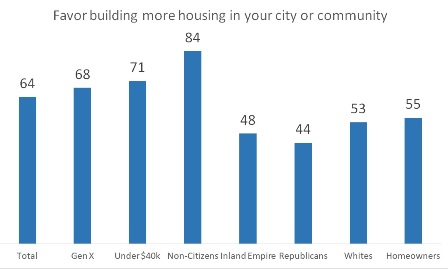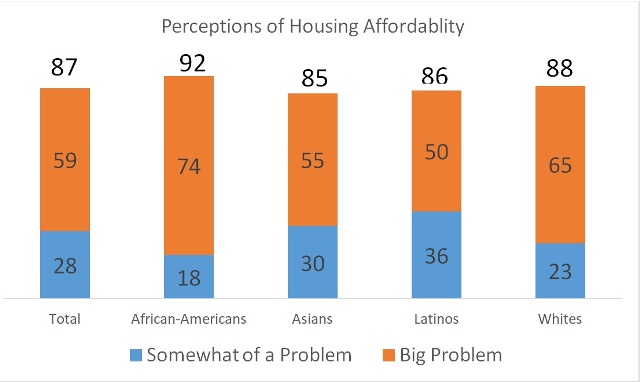News
Housing costs push Californians around
 Tightly packed housing in the Porter Ranch area of Los Angeles. (Photo: trekandshoot, via Shutterstock)>
Tightly packed housing in the Porter Ranch area of Los Angeles. (Photo: trekandshoot, via Shutterstock)>More than four in 10 California adults are seriously considering moving away from their part of the state because of the cost of housing, with the highest proportion in the coastal counties and the lowest in the state’s interior.
A slight majority of those recently surveyed by the Public Policy Institute of California — 55 percent — are staying put.
Along the expensive coastal areas the numbers are greatest: 53 percent in Orange/San Diego Counties, 49 percent in the Bay Area and 45 percent in Los Angeles, while it drops to 41 percent in the Inland Empire, and 35 percent in the Central Valley.
Strong majorities of adults favor building more housing in their communities to meet the current need in their part of the state (64 percent), believe that housing affordability is a big problem in their part of the state (59 percent) and favor changing California’s environmental regulations and local permitting process to make housing more affordable (61 percent). Seven out of 10 support a state bond to pay for affordable housing projects.
Andrew Smith, a retired Loomis resident took the survey, has a number of rental properties, and understands how difficult it must be for lower income individuals to buy a home, even in his inland area where housing costs are drastically lower than the coast.
“I just put myself in their position and if you work for minimum wage job there is not a way a couple could afford to buy a house because of the price of the homes,” said Smith. “When you have an average home for sale, a three bedroom for $250-350k, the average person cannot afford to but that and they have to rent.”
It’s data like this that excites, Brian Hanlon, executive director of the newly formed statewide group, CA YIMBY (Yes In My Backyard), that advocates for more housing development at all income levels.
“I think this shows how those people that speak at planning commission meetings are not the voice of California. More Californians support more home building in their communities,” said Hanlon. “There is a vocal minority that works to stop home building. The point of CA YIMBY is to provide a countervailing voice to NIMBYs.”
Although Hanlon is pro-development, he considers himself an environmentalist, and he has worked for the U.S. Forest Service and the U.S. Environmental Protection Agency.
Hanlon argues that “infill” housing development in urban areas will help protect the environment by removing cars from the roads, decreasing suburban sprawl, and helping people live near their jobs. Infill development includes the construction of homes in the gaps between the suburbs and the urban core, thus reducing long commutes and cutting air pollution.
“I really take issue with an environmental groups, especially local Sierra Clubs, especially when the national Sierra Club has great policies around urban infill housing and the local groups completely flout what the national group says,” said Hanlon.
Minda Berbeco, director of the Sierra Club’s San Francisco Bay Chapter, said her chapter “has a strong record of support for affordable infill housing to solve the housing crisis and protect against sprawl.”
In a prepared statement, she said she backed efforts “to provide housing for all Bay Area residents, except when the process unnecessarily threatens fundamental environmental principles, like protecting environmental review and preventing pollution.”
The strongest support for building more housing comes from Millennials (66 percent) and Generation X (68 percent), but Baby Boomers and the Silent Generation (58 percent) are also supportive. The have-nots are also most supportive, 69 percent of those with only a high school education, 71 percent of those making under $40k, 73 percent of renters, and 84 percent of non-citizens.
The only groups that do not support new housing are the Inland Empire, where there is even split, 48 percent supportive and 48 percent opposed, where the state population has grown the most and it’s difficult to keep up with infrastructure and Republicans, who are 52 percent opposed. Whites are not opposed, but just 53 percent support building more housing.

There may be a connection between of Republicans and white progressives in the data, in their support, or lack of support in building more housing. “Wealthy white progressives act a lot like wealthy white Republicans in terms of land use politics in many cases,” said Hanlon.
Every demographic group supports changing environmental regulations and local permitting process as a ways to make housing affordable in California. Sixty-nine percent of Conservatives support reducing regulation to boost housing development, an interesting juxtaposition with Republicans who don’t want to see more housing built but. Sixty-three percent of moderates, and even a majority of Liberals (53 percent) support changing environmental regulations and the permitting process.
“I’m not opposed to environmental regulations except they get stupid and they start regulating things that shouldn’t be regulated and put a burden on people,” said Robert Shields of Fresno.
Among racial groups, Latinos (80 percent), African-Americans (72 percent) are most supportive of changing regulations and permitting processes, followed by Asian (58 percent) and whites (47%).
While a few groups don’t want to see more housing, 9 out of 10 adults believe housing affordability is a problem in their part of California, that includes 92 percent of African-Americans, 85 percent of Asians, 86 percent of Latinos, and 88 percent of whites. The Bay Area is bleeding the most where 93 percent say it’s a problem, 90 percent in Los Angeles, 88 percent in Orange/San Diego, 81 percent in the Inland Empire, 79 percent Central Valley.
Want to see more stories like this? Sign up for The Roundup, the free daily newsletter about California politics from the editors of Capitol Weekly. Stay up to date on the news you need to know.
Sign up below, then look for a confirmation email in your inbox.

Leave a Reply